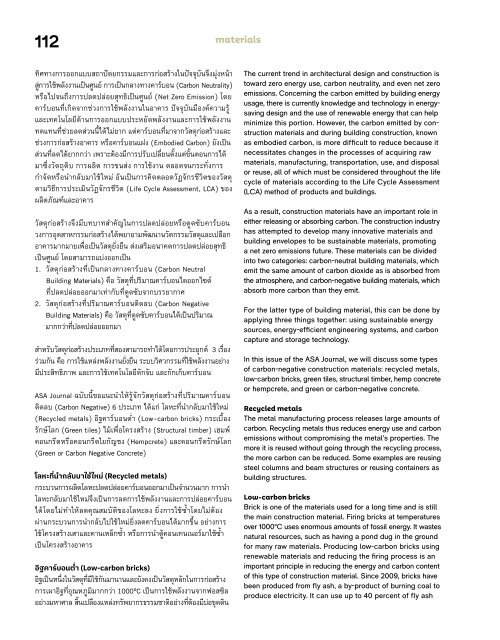ASA Journal 15/2023
Create successful ePaper yourself
Turn your PDF publications into a flip-book with our unique Google optimized e-Paper software.
112<br />
materials<br />
ทิศทางการออกแบบสถาปัตยกรรมและการก่อสร้างในปัจจุบันจึงมุ่งหน้า<br />
สู่การใช้พลังงานเป็นศูนย์ การเป็นกลางทางคาร์บอน (Carbon Neutrality)<br />
หรือไปจนถึงการปลดปล่อยสุทธิเป็นศูนย์ (Net Zero Emission) โดย<br />
คาร์บอนที่เกิดจากช่วงการใช้พลังงานในอาคาร ปัจจุบันมีองค์ความรู้<br />
และเทคโนโลยีด้านการออกแบบประหยัดพลังงานและการใช้พลังงาน<br />
ทดแทนที่ช่วยลดส่วนนี้ได้ไม่ยาก แต่คาร์บอนที่มาจากวัสดุก่อสร้างและ<br />
ช่วงการก่อสร้างอาคาร หรือคาร์บอนแฝง (Embodied Carbon) ยังเป็น<br />
ส่วนที่ลดได้ยากกว่า เพราะต้องมีการปรับเปลี่ยนตั้งแต่ขั้นตอนการได้<br />
มาซึ่งวัตถุดิบ การผลิต การขนส่ง การใช้งาน ตลอดจนกระทั่งการ<br />
กำาจัดหรือนำากลับมาใช้ใหม่ อันเป็นการคิดตลอดวัฏจักรชีวิตของวัสดุ<br />
ตามวิธีการประเมินวัฏจักรชีวิต (Life Cycle Assessment, LCA) ของ<br />
ผลิตภัณฑ์และอาคาร<br />
วัสดุก่อสร้างจึงมีบทบาทสำาคัญในการปลดปล่อยหรือดูดซับคาร์บอน <br />
วงการอุตสาหกรรมก่อสร้างได้พยายามพัฒนานวัตกรรมวัสดุและเปลือก<br />
อาคารมากมายเพื่อเป็นวัสดุยั่งยืน ส่งเสริมอนาคตการปลดปล่อยสุทธิ<br />
เป็นศูนย์ โดยสามารถแบ่งออกเป็น<br />
1. วัสดุก่อสร้างที่เป็นกลางทางคาร์บอน (Carbon Neutral<br />
Building Materials) คือ วัสดุที่ปริมาณคาร์บอนไดออกไซด์<br />
ที่ปลดปล่อยออกมาเท่ากับที่ดูดซับจากบรรยากาศ<br />
2. วัสดุก่อสร้างที่ปริมาณคาร์บอนติดลบ (Carbon Negative<br />
Building Materials) คือ วัสดุที่ดูดซับคาร์บอนได้เป็นปริมาณ<br />
มากกว่าที่ปลดปล่อยออกมา<br />
สำาหรับวัสดุก่อสร้างประเภทที่สองสามารถทำ าได้โดยการประยุกต์ 3 เรื่อง<br />
ร่วมกัน คือ การใช้แหล่งพลังงานยั่งยืน ระบบวิศวกรรมที่ใช้พลังงานอย่าง<br />
มีประสิทธิภาพ และการใช้เทคโนโลยีดักจับ และกักเก็บคาร์บอน<br />
<strong>ASA</strong> <strong>Journal</strong> ฉบับนี้ขอแนะนำาให้รู้จักวัสดุก่อสร้างที่ปริมาณคาร์บอน<br />
ติดลบ (Carbon Negative) 6 ประเภท ได้แก่ โลหะที่นำากลับมาใช้ใหม่<br />
(Recycled metals) อิฐคาร์บอนต่ำา (Low-carbon bricks) กระเบื้อง<br />
รักษ์โลก (Green tiles) ไม้เพื่อโครงสร้าง (Structural timber) เฮมพ์<br />
คอนกรีตหรือคอนกรีตใยกัญชง (Hempcrete) และคอนกรีตรักษ์โลก<br />
(Green or Carbon Negative Concrete)<br />
โลหะที่่นำากลับมิาใชิ้ ใหมิ่ (Recycled metals)<br />
กระบวนการผลิตโลหะปลดปล่อยคาร์บอนออกมาเป็นจำานวนมาก การนำา<br />
โลหะกลับมาใช้ใหม่จึงเป็นการลดการใช้พลังงานและการปล่อยคาร์บอน<br />
ได้โดยไม่ทำาให้ลดคุณสมบัติของโลหะลง ยิ่งการใช้ซ้ำาโดยไม่ต้อง<br />
ผ่านกระบวนการนำากลับไปใช้ใหม่ยิ่งลดคาร์บอนได้มากขึ้น อย่างการ<br />
ใช้โครงสร้างเสาและคานเหล็กซ้ำา หรือการนำาตู้คอนเทนเนอร์มาใช้ซ้ำา<br />
เป็นโครงสร้างอาคาร<br />
อิฐคาร์บอนต้ำ า (Low-carbon bricks)<br />
อิฐเป็นหนึ่งในวัสดุที่มีใช้กันมานานและยังคงเป็นวัสดุหลักในการก่อสร้าง<br />
การเผาอิฐที่อุณหภูมิมากกว่า 1000ºC เป็นการใช้พลังงานจากฟอสซิล<br />
อย่างมหาศาล สิ้นเปลืองแหล่งทรัพยากรธรรมชาติอย่างที่ต้องมีบ่อขุดดิน<br />
The current trend in architectural design and construction is<br />
toward zero energy use, carbon neutrality, and even net zero<br />
emissions. Concerning the carbon emitted by building energy<br />
usage, there is currently knowledge and technology in energysaving<br />
design and the use of renewable energy that can help<br />
minimize this portion. However, the carbon emitted by construction<br />
materials and during building construction, known<br />
as embodied carbon, is more difficult to reduce because it<br />
necessitates changes in the processes of acquiring raw<br />
materials, manufacturing, transportation, use, and disposal<br />
or reuse, all of which must be considered throughout the life<br />
cycle of materials according to the Life Cycle Assessment<br />
(LCA) method of products and buildings.<br />
As a result, construction materials have an important role in<br />
either releasing or absorbing carbon. The construction industry<br />
has attempted to develop many innovative materials and<br />
building envelopes to be sustainable materials, promoting<br />
a net zero emissions future. These materials can be divided<br />
into two categories: carbon-neutral building materials, which<br />
emit the same amount of carbon dioxide as is absorbed from<br />
the atmosphere, and carbon-negative building materials, which<br />
absorb more carbon than they emit.<br />
For the latter type of building material, this can be done by<br />
applying three things together: using sustainable energy<br />
sources, energy-efficient engineering systems, and carbon<br />
capture and storage technology.<br />
In this issue of the <strong>ASA</strong> <strong>Journal</strong>, we will discuss some types<br />
of carbon-negative construction materials: recycled metals,<br />
low-carbon bricks, green tiles, structural timber, hemp concrete<br />
or hempcrete, and green or carbon-negative concrete.<br />
Recycled metals<br />
The metal manufacturing process releases large amounts of<br />
carbon. Recycling metals thus reduces energy use and carbon<br />
emissions without compromising the metal’s properties. The<br />
more it is reused without going through the recycling process,<br />
the more carbon can be reduced. Some examples are reusing<br />
steel columns and beam structures or reusing containers as<br />
building structures.<br />
Low-carbon bricks<br />
Brick is one of the materials used for a long time and is still<br />
the main construction material. Firing bricks at temperatures<br />
over 1000ºC uses enormous amounts of fossil energy. It wastes<br />
natural resources, such as having a pond dug in the ground<br />
for many raw materials. Producing low-carbon bricks using<br />
renewable materials and reducing the firing process is an<br />
important principle in reducing the energy and carbon content<br />
of this type of construction material. Since 2009, bricks have<br />
been produced from fly ash, a by-product of burning coal to<br />
produce electricity. It can use up to 40 percent of fly ash

















